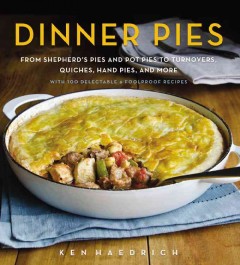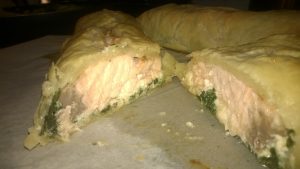
Bibliobites in February: Pie: It’s What’s For Dinner
Do you, like author Ken Haedrich, have a “lust for crust”? As our Bibliobites group discovered through this month’s title, pie crust (and its cousins) isn’t just for dessert anymore– it’s for pot pies, galettes, quiches, strudels, handpies, and tarts. Many of these dishes are familiar cold-weather favorites, but this book introduces some variations we’d never seen, as well as twists on tried-and-true favorites. But the common thread is, of course, the crust; and this topic made for an active discussion!
As it turns out, some in the group are not fond of pie crust at all. How can this be?? Some do not enjoy making the crust, with all its fussy details (more on that in a moment), and some thought the most frequently used crust in the book (the “go-to pie dough”) had too much fat in general, and too much butter in particular. Many of the recipes contained cream, cheese, or sausage; and adding pie crust to this mix just seemed to put the whole dish over the top in terms of fat and calories. Many of the pot pie and shepherd’s pie recipes called for both a top and bottom crust, which some thought was the “correct” way, and some felt was overkill, as they prefer only a top crust.
The details of making the pie crust sent some of us over the edge. In his zeal to demystify crust-making, author Haedrich is very, very specific about how to treat both the ingredients and the mixing process. Perhaps that is why he is known as the “Dean” of The Pie Academy. There are many steps and multiple pauses to chill the dough at various stages, which meant you had to set aside a fair amount of time to complete everything. For some of us, the precise instructions increased anxiety, rather than giving us confidence; we worried that forgetting one part of a step or mistiming another would lead to disaster. The overall methodology was a bit odd for those of us with prior pie crust experience, and the author didn’t explain why he made certain recommendations. We weren’t sure if the extra attention to detail made a noticeable difference in the final product.

But we did make lots of pies! Among the ones we tried were the old-fashioned chicken and biscuits, which was solidly good but time-consuming and made lots of dirty dishes. But more than one person commented that the biscuits were “to die for!” The turkey crumb pot pie had a topping made of crushed stuffing mix and french-fried onions, which was delicious and easier than making a crust; though the recipe called for a bottom crust, it was omitted for the sake of speed. The meatloaf wellington was a bit of a pain to make– it was hard to wrap the crust completely around the meatloaf, and of course the crust beneath the meatloaf stayed mushy. The meatloaf itself was good but not outstanding, so overall it didn’t seem worth the trouble or the calories! The tarte choucroute was different and delicious; but as with many of these recipes, you needed a lot of lead time to make, chill, and par-bake the crust. And the filling also needed to be cooked ahead and cooled before final assembly. The savory winter vegetable crisp had a cracker-crumb crust that was fairly simple to make; the vegetable combination was enjoyable and it made a large quantity. The downside– it took a long time to prepare, so dinner was much later than desired! The sausage and Guinness pot pie was requested by “Mr. Fussy,” and despite the cook’s doubts about the combination of ingredients, they both loved it. Whew! Three galettes that we enjoyed were the sweet potato and herb Parmesan, the kale, potato, and ricotta, and the curried winter squash. The smoky bacon and cheddar cheese quiche and the shepherd’s pie both suffered from having a not-quite-done bottom crust, despite faithful adherence to par-baking instructions.

Not to be deterred, when our intrepid cook next made the fresh corn pudding pie she “baked the hell out of the crust” before filling it, and this worked better. All three pies were tasty, though. We tried a couple of hand pies too: the Cornish meat pies and the chicken, broccoli, and cheddar turnovers were good and hearty. And the tempeh and brown rice empanadas were successful, too; they were made with a wrapper of pizza dough rather than the called-for pie crust!

The taco pot pie had a crust with some cornmeal in it, which was pleasantly different; it made a large casserole so it was fortunate that it was tasty! One member “went rogue” and found her own recipe for a spinach pie seasoned with sumac; it had a yeasted crust. Sounds good, and similar to this recipe?
The book itself was praised for its beautiful and numerous photographs; and as always, we like when the book stays open on the counter, as this one did. While recipe instructions could sometimes be overly detailed, they usually resulted in a successful product. We enjoyed reading the text; author Haedrich has a distinctive “voice” that always sounds friendly and down-to-earth; we could see ourselves enjoying a conversation with him about almost anything. If we sat down with him, here’s what we’d like him to know: “Ken, your pies are great– they make a lot of solidly good food and are perfect when you’re in the mood for some comfort food and have an afternoon to give to a cooking project. We could do with some quicker choices for a weeknight, though, and– enough with the crust already! We don’t really share your obsession, though we appreciate your quest for perfection.”
In the end we agreed that this book had some delicious choices; it’s just not a title that’s very practical for everyday cooking, and if you don’t care for pie crust then definitely don’t bother with this book. The majority of our group members gave this book 4 chef’s hats (out of a possible 5); but the overall average was 3.5, reflecting some “crust ambivalence.”
If you’d like to explore other Ken Haedrich cookbooks, he has written on everything from soup to vegetarian cooking to simple desserts. Check out the titles available here.
Next month’s title is Food52 Genius Recipes; copies are available at the main desk. We’ll next meet on March 31 at 11 AM in the Fireplace Room. Happy cooking!






